Electric fences are used to prevent wild animals from entering fields and to prevent livestock from leaving the premises. Although it depends on the function and scale, it is common to have a relatively inexpensive one of tens of thousands of yen, and it has become widely used in recent years because it can be easily introduced.
It is also sold in the anti-animal section of home centers, and it is becoming widely recognized, so even for those who are not familiar with it, the image of "electric fence? Somehow scary ..." is not fading. Huh?
However, since it is a device that gives an electric shock to the beast it touches and makes it scatter, there is also the risk of electric shock if used or installed incorrectly. In addition, it is important to understand the specifications firmly, as it may not be effective enough.
This time, we will explain the voltage of the electric fence for the safe and effective installation of the electric fence.
★Recommended electric fence
Click here for Inohoi's recommended electric fences.What does electric fence voltage mean?
Electric fence voltage includes "power supply voltage", "output voltage", and "voltage applied to the fence wire". If you are considering introducing an electric fence, it is a good idea to understand what these voltages refer to and what standards the product you are considering is based on.
Also, when understanding the specifications of electric fences, it will be easier to understand the standards if you know the difference between DC and AC.
There are two types of electric current: Direct Current (DC) and Alternating Current (AC). What does not change is direct current (DC).
The electricity that flows from a household outlet is alternating current, and the electricity that flows from a dry cell or battery is direct current. Electric products, including the electric fence itself, generally operate on direct current.
Power-supply voltage
It is the so-called power supply voltage input to the main body of the electric fence. The power supply includes A: dry battery, B: battery, and C: solar power generation, all of which normally have a voltage value of DC12V.
There is also a type that operates by connecting an adapter (AC adapter) that converts household AC100V power to DC12V.
output voltage
It refers to the voltage output from the main body of the electric fence. As shown in the figure below, the electric fence is designed to apply voltage to the entire body by connecting the main body (power supply: red device in the figure) and the electric wire (fence wire).

Output voltage refers to the voltage value output from the main unit. The maximum output voltage (the voltage value that is output under no load) is generally 10000V.
Quiet talk: Pulse output for safety
Mechanism of an electric fence: An electric shock (electric shock) occurs when an electric wire is touched and electricity flows through the body to the ground. In general, the degree of risk of electric shock increases as the duration of electric current multiplied by the strength of the electric current increases.In July 2015, an accident occurred in Nishiizu Town, Shizuoka Prefecture, in which a child was electrocuted while playing in a river when he touched an electric fence installed around a hydrangea field on the embankment to keep out pests. Six other people who tried to help the child who was electrocuted were also electrocuted one after another, and seven were taken to the hospital. Ultimately, two men in their 40s died, causing serious damage.
Later, it was discovered that the electric fence used in this accident was a self-made one, and that the 100V AC power was stepped up by a transformer circuit and energized directly to the fence wire.
Electric fences on the market are of a pulse output type that instantaneously flows electricity at intervals of about 1 second in order to prevent the above accidents. As a result, even if a human being is accidentally electrocuted, it is possible to leave immediately. In addition, safety regulations are stipulated by the Electricity Business Act and related ministerial ordinances, and electric fences on the market must be equipped with safety devices.
Therefore, electric fences on the market are designed to prevent electric shock accidents. Also, even if you touch it by mistake, it will only cause a strong pop of static electricity. It is a device whose purpose is to prevent it from happening).
voltage on the fence wire
The voltage applied to the fence wire is measured using a special tester (voltage detector). It is also essential to check whether there are any problems with the installation status. If nothing is touching the fence wire and it is well grounded, it will have enough voltage to function as an electric fence.
However, if there is an earth leakage, the voltage will drop. Common cases are cases where the fence wire is wrapped directly around the post without using an insulator, or where the fence wire touches the post because the insulator is not installed properly. Also, if the ground (earth) and the fence wire touch, the voltage will drop extremely.
Of course, even if the plants and trees growing from the ground are in contact, the voltage will drop significantly.
The fence line voltage at which the electric fence function is effective is about 3500V or more. Below this, the beast doesn't feel the electric shock, so the electric fence is useless.
If it is below the effective voltage when checked with a tester, it is considered that there is something wrong with the installation state. Refer to this article to check if the electric fence is installed properly, correct it as necessary, and measure the voltage again.
to maintain the voltage
・Various types of electric fence bodies are sold, but each has different abilities. Even if the main body looks similar, the upper limit of the fence line length that can be stretched is different. If the fence wire is stretched beyond the capacity of the main unit, it will not be possible to apply sufficient voltage. Before purchasing, check the length around the site, and if the length exceeds the capacity of the main unit, purchase multiple main units or purchase a main unit that can withstand long-distance installation.
・As mentioned above, the voltage drops significantly when plants touch the fence wire. Mowing the grass frequently or installing a weed control sheet (with a grounding function) for an electric fence is one way.
・Make sure that the ground of the tester is firmly buried in the ground during measurement. If the plug is loose, the voltage will not come out properly. The ground on the electric fence side must also be firmly inserted into the ground. If the ground is rusted or the conductor is cut, it needs to be replaced.
・Mount insulators properly. If the fence wire touches a conductive material, a short circuit will occur and the voltage will drop. After installation, it is a good idea to check frequently to ensure that the proper condition is maintained.

 箱罠
箱罠
 くくり罠
くくり罠
 パーツ類
パーツ類
 電気柵
電気柵
 自作キット
自作キット
 防獣グッズ
防獣グッズ
 監視カメラ
監視カメラ

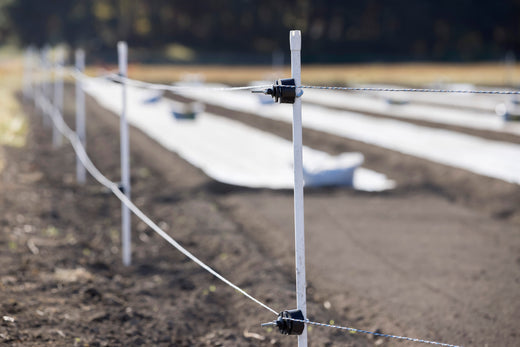

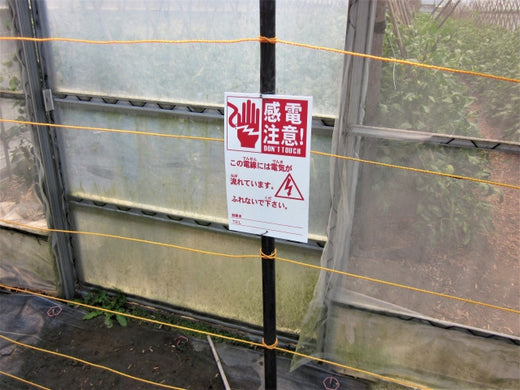
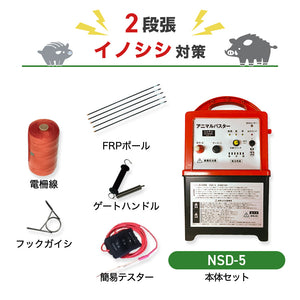
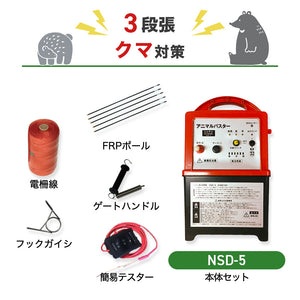
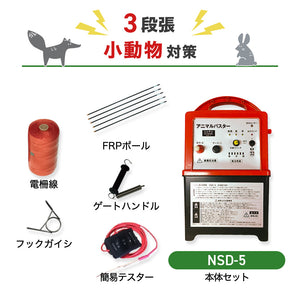
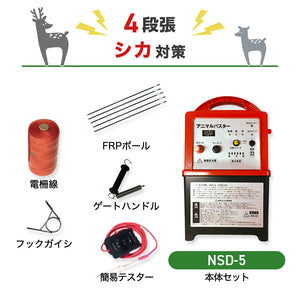
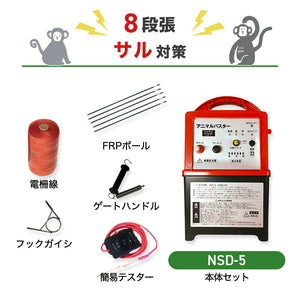
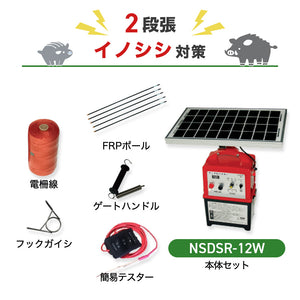
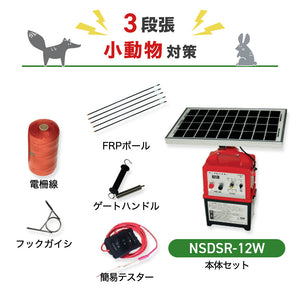
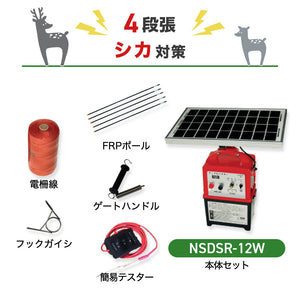
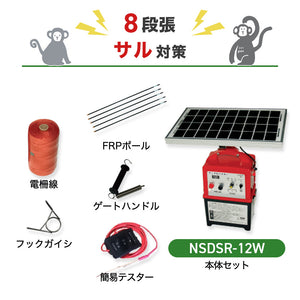
 box trap
box trap
 tying trap
tying trap
 enclosure trap
enclosure trap
 Prevention and avoidance goods
Prevention and avoidance goods
 electric fence
electric fence
 trap surveillance camera
trap surveillance camera
 transportation goods
transportation goods
 Trap detection sensor
Trap detection sensor
 hunting supplies
hunting supplies
 hunting books
hunting books
 Anti-bird goods
Anti-bird goods
 Agricultural materials/machinery
Agricultural materials/machinery
 boar
boar
 deer
deer
 Kyon
Kyon
 monkey
monkey
 raccoon
raccoon
 Badger
Badger
 palm civet
palm civet
 raccoon dog
raccoon dog
 nutria
nutria
 mouse or rat
mouse or rat
 Mole
Mole
 bear
bear
 pigeon
pigeon
 Crow
Crow







